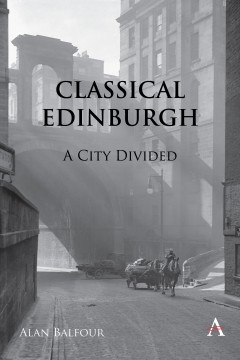Classical Edinburgh
A City Divided
By Alan H Balfour
Other Formats Available:
- About This Book
- Reviews
- Author Information
- Series
- Table of Contents
- Links
- Podcasts
About This Book
This work is both a family history and asocial history of Scotland with a particular focus on Edinburgh. The families are traced from their roots in the seventeenthcentury into the twentieth. However, all their wandering and failures, and births and marriages, are in themselves of no importance – they are merely the actions of helpless actors (one not so helpless) caught in the midst of changing worlds and realities. The book embeds their lives into the larger forces shaping the Scottish culture, climaxing in the creation of the New Town of Edinburgh, one of the eighteenthand nineteenth century’s most extravagant romantic fantasies. It was a reality shaped by the leaders of the Scottish Enlightenment to give identity to a capital of a nation in name only, after the closing of the Scottish parliament with the Union of the Crowns in 1707.
This New Town became a vast idealised reality, which could only have been achieved in a Scotland that was and remains essentially feudal. All the lands surrounding the walls of the old city were the inherited properties of a few aristocratic families who were able, free of constraint, to sustain a succession of developments for over 80years, creating a continual stream of wealth for the landowners and their successors, and in the process producing extreme poverty for those left behind.
By the mid-nineteenth century, a very different reality emerged out of the need to accommodate the poor and the rising workforce in the city’s new industries. This resulted in street after street of monotonous, identical tenements, a joyless demeaning world in stark contrast to the lively grandeur of the housing in the New Town. The medieval tenements of city’s old High Street were once called ‘slums built to last a thousand years’, and in many ways the extensive tenements of the industrial city from the nineteenth and twentieth century can equally be said to represent the prospect of people divided for a thousand years. It will be argued that such division are unavoidable and can be found in many cities, but it is the extent and the willfulness of the planning that makes the Edinburgh example so potent.
Reviews
"Balfour has an impressive record of writing architectural history; his book on Berlin is magnificent, and he does not disappoint here. Here is an architectural history, written by an expert, writing about ‘his’ city, the one which formed him. He takes an orthodoxy, telling Edinburgh’s architectural story and threads it through his family narrative. Hard to do; but he succeeds" — David McCrone, The University of Edinburgh.
"There is a popular misconception that Edinburgh’s New Town is a homogeneous social model. In this painstakingly researched and beautifully illustrated book Alan Balfour reveals a different reality tracing the extreme hardship and poverty endured by his family during the construction of the New Town, the decline of the Old Town and beyond" — Mick Duncan, Scottish architect.
Author Information
Alan Balfour is an author and architect. His most recent work,The Walls of Jerusalem, Preserving the Past Controlling the Future, was published in 2019.
Series
Table of Contents
Prologue; I Poverty, Filth and Bondage; II Ambition; III The New Town of Edinburgh.; IV The New Society; V Building Status; VI The Other New Town; VII Into The Twentieth Century; VIII Reflections; VIII Methods and Sources; Bibliography
Links
Stay Updated
Information
Latest Tweets



